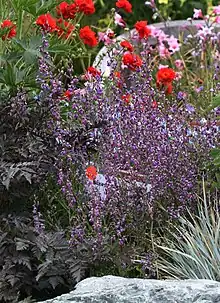Streptanthus albidus
Streptanthus albidus is a species of flowering plant in the mustard family known by the common name Metcalf Canyon jewelflower.[1][2] It is endemic to California, where it is known only from the Central Coast Ranges and San Francisco Bay Area. It grows in open areas such as grasslands, often on serpentine soils.
| Streptanthus albidus | |
|---|---|
 | |
| ssp. peramoenus in a nursery | |
| Scientific classification | |
| Kingdom: | Plantae |
| Clade: | Tracheophytes |
| Clade: | Angiosperms |
| Clade: | Eudicots |
| Clade: | Rosids |
| Order: | Brassicales |
| Family: | Brassicaceae |
| Genus: | Streptanthus |
| Species: | S. albidus |
| Binomial name | |
| Streptanthus albidus | |
Description
It is an annual herb producing an erect, usually branching stem up to a meter tall or slightly taller. There are bristly hairs around the base. The basal leaves are lance-shaped with toothed edges and are borne on winged petioles. Leaves farther up the stem are smaller and narrower, sometimes linear in shape, and toothed or smooth-edged. Flowers occur at intervals along the upper stem. Each has a spherical to urn-shaped calyx of keeled sepals about a centimeter long with curving petals emerging from the tip. The calyx of sepals may be white to purple, depending on subspecies. The fruit is a long, narrow silique which may be 12 centimeters in length.
Subspecies
There are two subspecies, both rare.
- The rarer of the two, ssp. albidus, is federally listed as an endangered species of the United States. It is endemic to Santa Clara County, where it is known from nine recent occurrences.[3] This subspecies has white or green-tinged sepals.
- The other subspecies, ssp. peramoenus, the most beautiful jewelflower or uncommon jewelflower, is known from several locations in the Bay Area and several near San Luis Obispo. It has pale to dark purple sepals and purplish petals.
Distribution
The jewelflower is found in a variety of locations, however it has a limited distribution. It is widespread all along the California Coast in a smaller groups. The flower itself does not have large populations but rather smaller groups, also known as an extensive colony. where the soil is extremely dry. Some counties where they can be found include:
- Tehama
- Mendocino
- San Luis Obispo
- Kern County
- Tulare County
More specifically these flowers can be found in isolated an iaccessible mountains. It can be found in a variety of soils including rock, gravel, to heavy clay. The counties listed above include other subspecies of the flower, where albidus is more central to San Fransisco Bay Area.
Threats and Conservation Efforts
This flora is currently considered endangered according to the U.S. Fish and Wildlife Services. It was added to the US Forest Service's watch list in 2003. There are a multitude of threats facing these plants. A lot of these animals are threatened by wind turbine facilities and off highway vehicle automotive usage. Cars trucks damage the soil and disturb the ground environment. Another threat that is very common in California are frequent fires and those in the wrong season. There could also be the potential threat from cattle grazing or logging in the near future. As of now there are no specific conservation efforts in place to protect these flowers.
